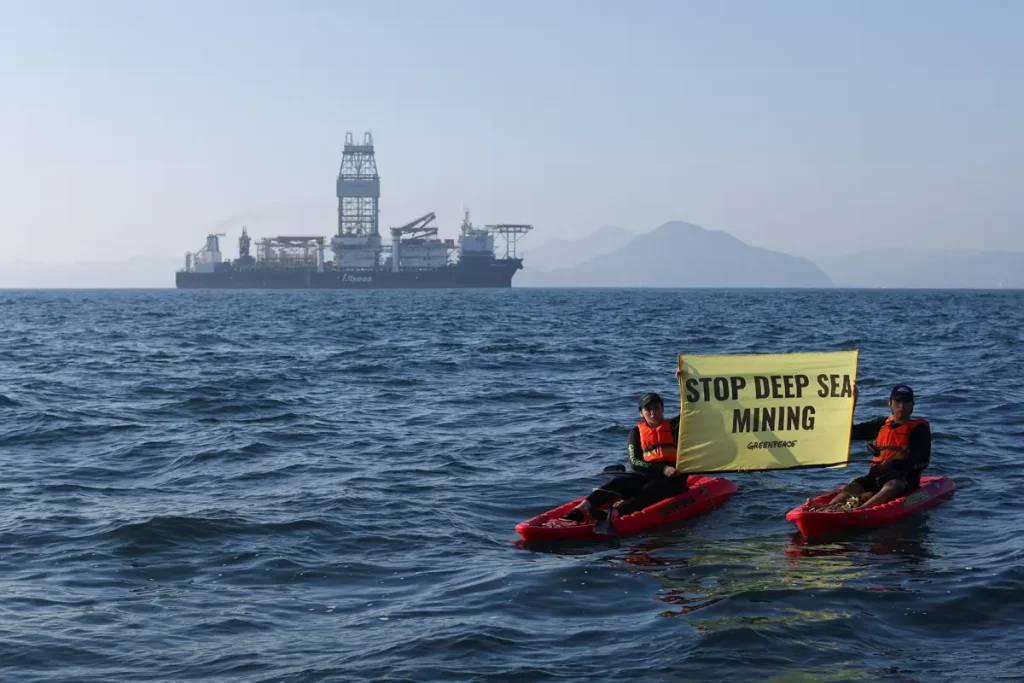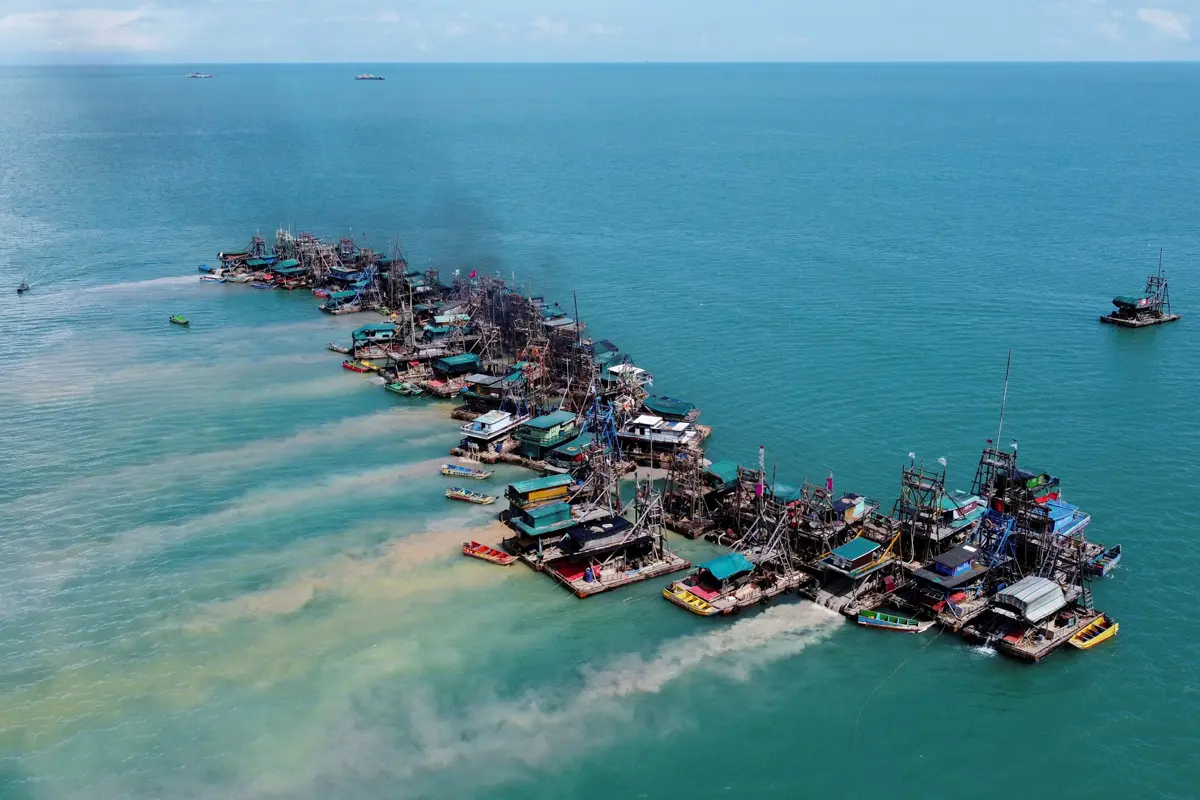Deep-sea mining: ravaging the oceans in the name of transition. Norway is the first country in the world to say yes to finding raw materials in the ocean depths. Environmentalists take action
What is the meaning of deep-sea mining?
Deep-sea mining is the process of extracting and often excavating mineral deposits from the deep seabed. The deep seabed is the seabed at ocean depths greater than 200m, and covers about two-thirds of the total seafloor. Research suggests deep-sea mining could severely harm marine biodiversity and ecosystems, but we still lack the knowledge and means to implement protections.
Despite this, there is growing interest in the mineral deposits of the seabed. This is said to be due to depleting terrestrial deposits of metals such as copper, nickel, aluminium, manganese, zinc, lithium and cobalt. Demand for these metals is also increasing to produce technologies like smartphones, wind turbines, solar panels and batteries.
The Norwegian Parliament greenlights deep sea mining despite environmental concerns
On Tuesday, 9 January 2024, the Norwegian Parliament (Storting) approved with eighty votes in favor and twenty against the national government proposal to open up a part of its seabed in the Arctic waters for the exploration and extraction of deep sea minerals, raw materials employed in the production of technologies ranging from batteries to smartphones in a move away from ocean preservation.
The seabed in question is located between Norway, Greenland, the Svalbard archipelago, and Iceland and is estimated to be 280.000 kilometers (108.108 square miles) bigger than the United Kingdom.
The extraction won’t start immediately after this decision, as the Scandinavian country’s Parliament must approve each commercial license. This decision makes Norway one of the first countries to open the door to commercial deep-sea mining.
Deep sea mining – raw materials from the bottom of the oceans
Deep-sea mining (DSM) removes mineral reserves from the ocean floor at a depth of more than 200 meters, resources that can be found in deep waters across the globe, including the Arctic area.
Rising demand for these raw materials, such as aluminum, copper, cobalt, and lithium, as well as the discoveries of mineral deposits in the depths of our ocean, such as polymetallic sulfides, cobalt-rich ferromanganese crusts, and polymetallic nodules, are driving the trend toward deep-sea mining.
This interest in deep sea mining has been met with concern from the scientific community, environmental activists, and many politicians, given its potential effects on the seas, which make it antithetical to ocean preservation.
Doubts have been raised about the need to extract these raw materials from the seabeds if circular economy practices were implemented to keep them in the loop through recycling practices, sustainable product design, and the right to repair.
The ecosystems that would be impacted if deep sea mining activities were to be approved would be interconnected and intricate ones that are, for the most part, still unexplored. To this day, in fact, only one percent of the deep sea has been explored.

The timeline of Norway’s steps toward deep sea mining
This decision made by the Norwegian Parliament is the result of a long process. The Norwegian Offshore Directorate has been mapping parts of the northern Norwegian Sea since 2017, and the Norwegian Ministry of Petroleum and Energy started the opening process in 2020.
In January 2023, the Norwegian Offshore Directorate (Oljedirektoratet or OD) released a resource assessment of the seabed minerals on the Norwegian continental shelf.
About six months later, the Norwegian Ministry of Petroleum and Energy manifested its interest in facilitating the deep sea industry by opening areas of its continental shelf for commercial seabed mineral activities, with the intent of establishing the Scandinavian country as «a global leader in a fact- and knowledge-based management of seabed mineral resources». The reasoning given in this occasion for this move towards commercial deep sea mining were job creation and ensuring a value chain for raw materials employed in the global energy transition.
The Norwegian Environment Agency, in its evaluation of the government’s impact assessment, has concluded that it shows a lack of knowledge in terms of nature, technology, and environmental effects and whether it would be possible to operate deep-sea operations in a responsible and environmentally sustainable manner.
In addition, they highlighted a discrepancy between the assessment and the Seabed Minerals Act, the act regulating mineral activities on the national continental shelf.
Ocean preservation: how could extracting raw materials through deep sea mining affect its fauna?
The fauna living in these uncharted waters could perish due to the movement of sediments and be impacted by the sediment plumes generated by the mining operations and the machinery-induced noise and light pollution, which would disrupt the conditions of environments characterized by darkness and silence.
These disruptions would happen in fragile ecosystems that are fundamental for the well-being of our planet. The oceans, in fact, absorb anthropogenic carbon dioxide (CO2) emissions, acting as a carbon sink, and its depths are home to wildlife and wildernesses that can be found nowhere else on Earth.
International Union for Conservation of Nature: Deep-sea mining has no place in a sustainable future
As the International Union for Conservation of Nature (IUCN) highlighted, the knowledge gaps exacerbate the risks connected to this practice, as they hinder the implementation of protection measures.
One of the animals that would be impacted by deep sea mining is the deep-sea jellyfish Periphylla periphylla, according to a study published in Nature Communications in November 2023. The researchers from the GEOMAR Helmholtz Centre for Ocean Research Kiel, the HYIG ARJEL, and the SAMS have found that deep-sea mining and warming trigger a stress response in this pelagic organism, which could be indicative of the impact extractive activities could have on deep-sea gelatinous fauna as a whole.
«Norway’s decision to greenlight deep-sea mining exploration in the fragile Arctic exposes Norway’s disregard for its international climate and nature commitments. Deep-sea mining has no place in a sustainable future for people and the planet. To date, 24 countries have already called for a moratorium or pause on this destructive industry in international waters. For the sake of current and future generations, we urge Norway to abandon its plans to mine and instead join the growing group of governments that are saying no to deep-sea mining». Said Sofia Tsenikli, Global Deep Sea Mining Campaign Lead at the Deep Sea Conservation Coalition.
The reaction to the Norwegian parliament decision
This controversial decision has been made despite the scientists’ opinions on the dangers of deep sea mining, opposition from civic society, and international criticism. «This is a disaster for the ocean, and shameful for Norway. The Norwegian government is not only ignoring hundreds of concerned scientists, but also showing disregard for its international obligations and national environmental legislation. By opening up for deep sea mining, Norway has lost all credibility as a responsible ocean nation that signed the UN Ocean Treaty». Frode Pleym, Head of Greenpeace Norway, said in the wake of this decision.
The European Union Commission has voiced concerns regarding the project’s environmental effects, and 119 European lawmakers have issued an open letter to the Norwegian Parliament urging them to vote against it. Over 800 ocean scientists have urged a worldwide halt to deep sea mining. At a governance level, more than twenty countries from all across the globe, such as Canada, Mexico, France, and Fiji, have taken action against the practice of deep sea mining in international waters, whether through asking for a ban, moratorium, or a precautionary pause, prioritizing ocean preservation.
«For too long, we have treated the ocean as an endless dumping ground for human waste and taken life under water for granted. It is deeply worrying that Norway wants to bring yet another extractive industry into one of the most vulnerable ecosystems on Earth. The only silver lining of today is that the first extraction licenses must be passed through Parliament. The fight for the oceans continues». Said Anne-Sophie Roux, Deep Sea Mining Europe Lead at Sustainable Ocean Alliance.
Circular economy – can recycling ensure the raw material for the green transition?
The increase in demand for minerals that is expected to happen due to the shift to renewable energy sources is often cited as a reason to move forward with deep-sea mining. A new report by the Environmental Justice Foundation (EJF) has compiled data that disproves this argument, in favor of focusing on circular economy practices to ensure the supply of these minerals.
According to this report, this argument ignores the effect that batteries’ technological development might influence the demand for deep sea minerals. In addition, the combined impacts of circular economy initiatives, new technologies, and recycling might cut cumulative mineral demand by fifty-eight percent between 2022 and 2050. Recycled cobalt, nickel, and manganese have the ability to fulfill between eighty and ninety percent of the demand.



















